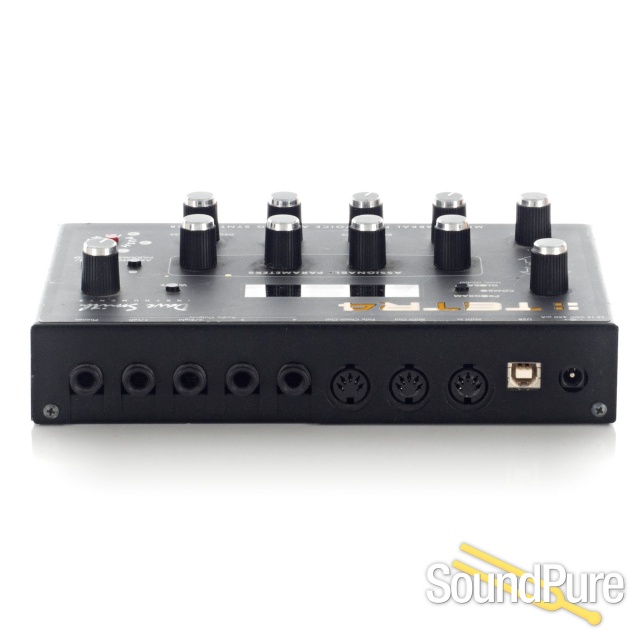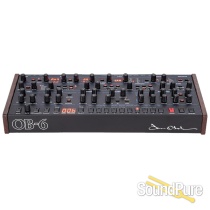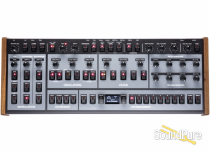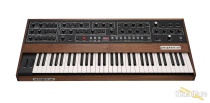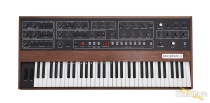-
Call Us Toll Free888-528-9703
-
Local/International (+1)919-682-5552
- Call Us! Toll Free! 888-528-9703
- Local / International (+1) 919-682-5552

Dave Smith Instruments TETR4 - Used From Sequential
Get this feature rich DCO based analog synth for a steal! It's in fantastic shape and sounds huge!
"Gone, Baby, Gone"
This one is sold. Don't miss the next one. Some things never even make it to the site so stay up to date on our used collection.
We get in many oddities, rare and vintage products, most of which go fast. If you're on the hunt for something specific, something unique, or something priced right, let us notify you on our used collection before the items even hit the site.
Want to know if one lands?
Notify MeWant to discuss what's coming?
Manufacturer's Description from Sequential
Four Multitimbral Voices of Analog Power
Tetra takes the award-winning sound and features of Mopho, multiplies them by four, and packs them in a box less than half an inch larger! Tetra has multiple personalities. It is a four-voice, analog poly synth, a sort of “mini Prophet.” It’s a four-part, multitimbral synth with separate outputs, essentially four Mophos in one very compact box. And it’s a voice expander for other Tetras or the Prophet ’08.
- Affordable, fully programmable poly synth with a 100% analog signal path.
- Classic, real analog sound—including legendary Curtis analog low-pass filter.
- Four-part multitimbral capability with four separate outputs.
- Combo Mode for huge unison patches, stacked sequences, and “modular-style” poly sounds.
- Expandable: poly chain with other Tetras, Prophet ’08, and Mopho for expanded polyphony
- Just 7.9″ x 5″ (20.07 cm x 12.7 cm).
Outside the Box
Physically, Tetra is similar to Mopho, with four assignable parameter controls per program and a row of controls dedicated to the most commonly used performance parameters. All of the parameters can be accessed from the front panel and Tetra is fully programmable. A free, downloadable editor is available for Mac OS and Windows to facilitate more comprehensive tweaking.
Most of the rotary controls are detented encoders, but Cutoff and Resonance are potentiometers, allowing full sweeps with a single turn. The Push It button is a manual trigger to play notes and latch sequences on without the need for a MIDI controller.
Audio is output in mono, stereo, or per voice, via the four audio output jacks. There is also a headphone out. MIDI communication is by standard MIDI in and out jacks or USB. Poly Chain Out is a special, dedicated MIDI output to chain multiple instruments for increased polyphony.
Under the Hood
The voice architecture is based on the Prophet ’08, but with the addition of a sub-octave generator for each oscillator and a fully programmable feedback loop for each voice. That breaks down to two DCOs, a resonant low-pass filter, three DADSR envelope generators, four LFOS, deep modulation routing, an arpeggiator, and a 16 x 4 analog-style step sequencer per voice. Feedback is capable of producing effects ranging from mild distortion to fairly extreme harmonic instability. (That’s a good thing.) The possibilities are nearly endless. And the audio signal path is 100% analog.
Tetra a la Mode
In Program Mode, Tetra is a four-voice, polyphonic synthesizer with four banks of 128 programs. As with the Prophet ’08, each program contains two layers—each layer is essentially a separate patch—that can be used to create keyboard splits or stacked sounds. Banks 1 and 2 are the Prophet ’08 factory programs; banks 3 and 4 are a combination of Mopho and new programs.
In Combo Mode, a different program can be assigned to each of the four voices. Combos can be used for mammoth unison patches or for triggering up to four different 16 x 4 sequences—each with its own program—simultaneously. Combos can also be used to create “modular-style” polyphonic patches, where each voice plays a different program, with a slight variation on the same sound or even a drastically different sound.
In Multi Mode, Tetra becomes a multitimbral sound module capable of playing four monophonic parts on four MIDI channels, with separate outputs for each voice. Coupled with a MIDI sequencer and DAW, Tetra can play complex arrangements or analog drum parts with each part individually processed and recorded to its own track.
This One Goes to 12…and 16
Up to four Tetras can be poly chained for eight, twelve, or sixteen voices total. When used with a Prophet ’08, up to two Tetras can be poly chained for a maximum of sixteen voices. In addition, the Prophet’s front panel controls map directly to almost all of Tetra’s parameters, so the Prophet acts as a programmer and control surface. And a Mopho can be connected to Tetra’s Poly Chain Out for five-voice operation.
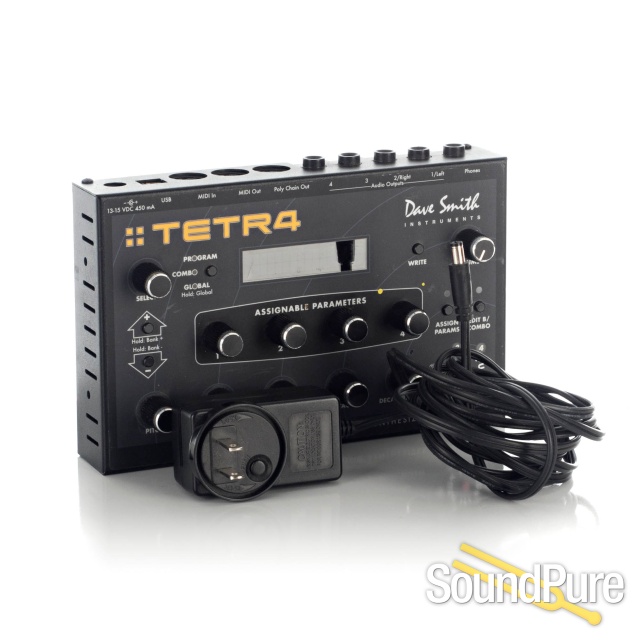
About Manufacturer
Sequential is helmed by legendary instrument designer and Grammy-winner Dave Smith, the original founder of Sequential Circuits in the mid-70s. Dave designed the Prophet-5, the world’s first fully-programmable polyphonic synth—and the first musical instrument with an embedded microprocessor.
Dave is generally known as the driving force behind the generation of the MIDI specification in 1981. It was Dave, in fact, who coined the acronym. In 1987 he was named a Fellow of the Audio Engineering Society (AES) for his continuing work in the area of music synthesis. After Sequential, Dave was President of DSD, Inc, an R&D division of Yamaha, where he worked on physical modeling synthesis and software synthesizer concepts. He then started the Korg R&D group in California, producing the Wavestation products and other technology.
He took over as President at Seer Systems and developed the first soft synth for Intel in 1994, followed by the first fully professional soft synth, Reality, released in 1997.
Realizing the limitations of software, Dave returned to hardware and started Dave Smith Instruments, which released the Evolver hybrid analog/digital synthesizer in 2002. Since then the Sequential product lineup has grown to include the Prophet X, Prophet Rev2, Prophet-6, OB-6, Pro 2, and Prophet 12 synthesizers, as well as the Tempest drum machine, co-designed with friend and fellow electronic instrument designer Roger Linn.
Dave is generally known as the driving force behind the generation of the MIDI specification in 1981. It was Dave, in fact, who coined the acronym. In 1987 he was named a Fellow of the Audio Engineering Society (AES) for his continuing work in the area of music synthesis. After Sequential, Dave was President of DSD, Inc, an R&D division of Yamaha, where he worked on physical modeling synthesis and software synthesizer concepts. He then started the Korg R&D group in California, producing the Wavestation products and other technology.
He took over as President at Seer Systems and developed the first soft synth for Intel in 1994, followed by the first fully professional soft synth, Reality, released in 1997.
Realizing the limitations of software, Dave returned to hardware and started Dave Smith Instruments which released the Evolver hybrid analog/digital synthesizer in 2002. Since then the DSI product lineup has grown to include the Prophet 12, Prophet ’08, Pro 2, Mopho, and Tetra synths, as well as the Tempest drum machine, co-designed with friend and fellow electronic instrument designer Roger Linn.
Specifications
Multitimbral four-voice analog synthesizer 100% analog signal path Two oscillators per voice (sawtooth, triangle, saw/triangle, square with variable pulse width) with hard sync White noise generator One classic Curtis low-pass filter (switchable 2- or 4-pole) per voice, self-oscillating in 4-pole mode Analog VCAs Three envelope generators (ADSR plus delay) per voice Four LFOs per voice Two sub-octave generators (one octave down and two octaves down) per voice Feedback loop per voice with programmable level and gain Four assignable performance controls per program Gated 16 x 4 step sequencer (one sequence per program) Arpeggiator Fully programmable (free downloadable software editor for Mac OS and Windows) 512 programs organized into four banks of 128; 128 combos
IN/OUT I/O: USB 2.0 (type B receptacle) MIDI In, MIDI Out/Thru, Poly Chain Out Audio Outs 1/Left, 2/Right, 3, and 4 (1/4″ unbalanced), 1/4″ Headphone out
PHYSICAL SPECS 7.9” L x 5” W x 2.7” H (20.07 cm x 12.7 cm x 6.86 cm) 1.8 lb. (0.81 kg)
INCLUDED Power supply for 100V – 240V AC operation Operation manual Free software editor for Mac OS and Windows available from SoundTower
